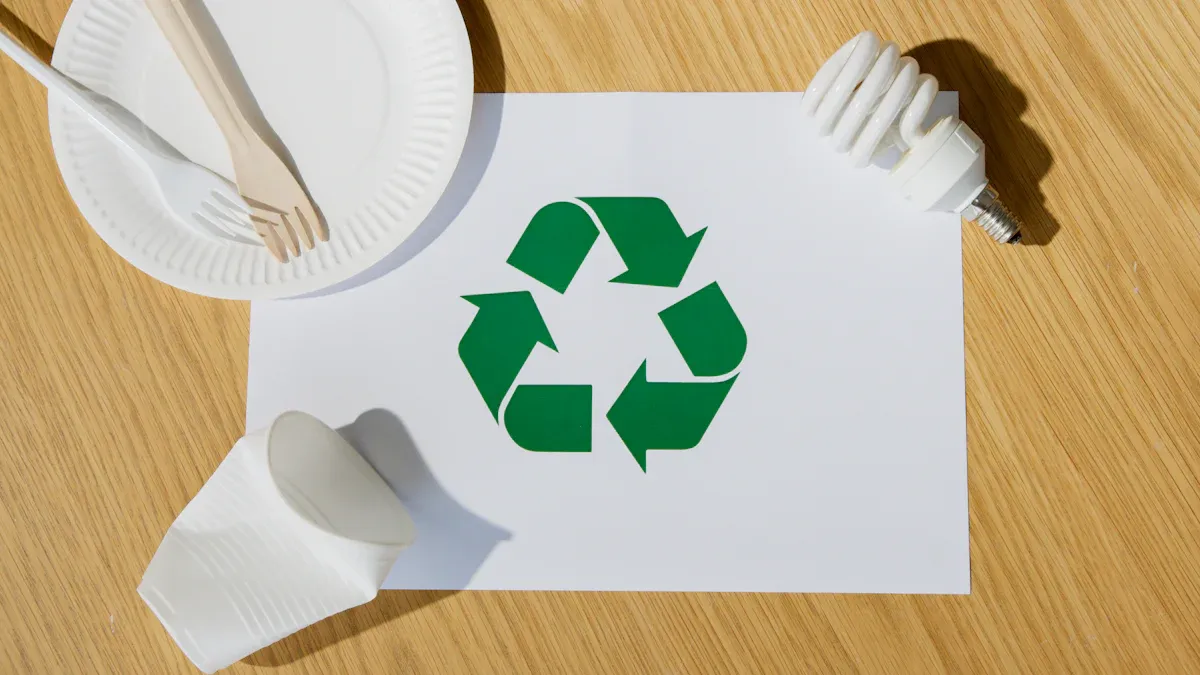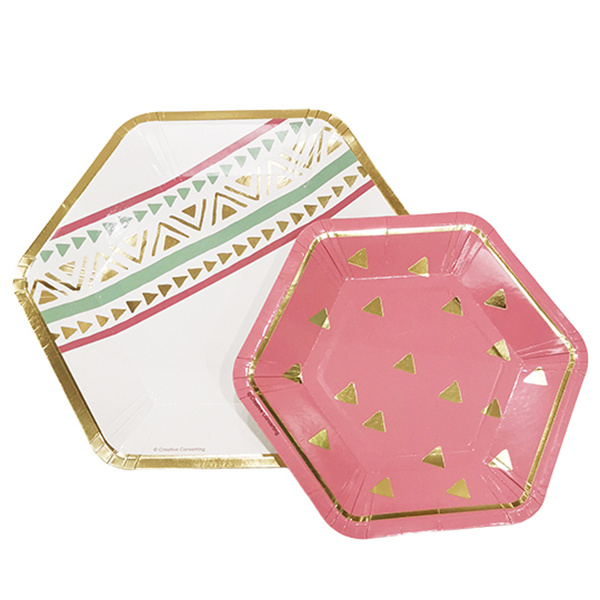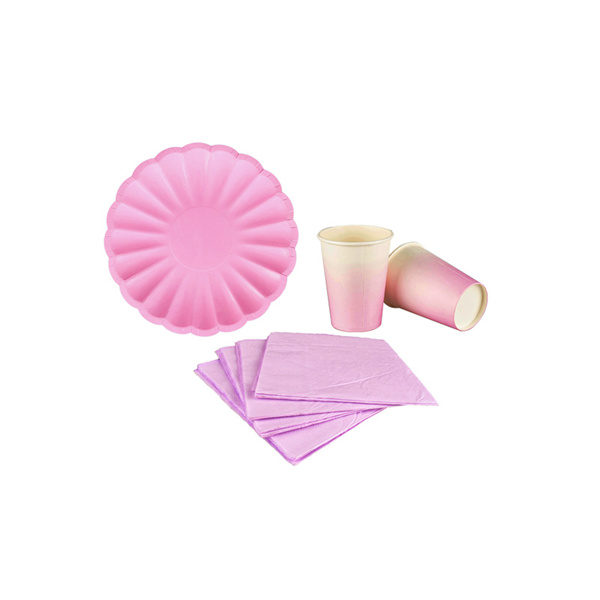
Biodegradable paper plates and cups are a crucial advancement in sustainable dining. These eco-friendly products, including biodegradable Bio Paper Plates, naturally decompose, alleviating the pressure on landfills and reducing pollution. The global market for biodegradable tableware highlights the increasing demand for such alternatives, reaching a value of approximately USD 16.71 billion in 2023 and projected to grow to USD 31.95 billion by 2033, with a compound annual growth rate (CAGR) of 6.70%. The plates segment alone represented 34.2% of the revenue share in 2023. Utilizing bio paper plates made from renewable resources like bamboo or bagasse significantly lowers the environmental impact. The bio paper plate raw material plays a vital role in promoting biodegradable solutions, making these products indispensable for a more sustainable future.
Key Takeaways
- Biodegradable paper plates and cups break down naturally. This helps reduce trash and pollution, making them eco-friendly.
- Using biodegradable items turns waste into useful resources. It helps the soil instead of hurting it.
- More people want eco-friendly dining options. Many are okay with paying extra for sustainable products, which helps businesses.
- Materials like sugarcane bagasse and bamboo are renewable and safe for food. They are a good replacement for plastic.
- Switching to biodegradable tableware is simple. It helps the planet and encourages others to do the same.
The Environmental Impact of Traditional Disposable Products

Plastic and Styrofoam Waste in Landfills
Plastic and Styrofoam waste has become a significant environmental concern. In 2018, landfills received 27 million tons of plastic waste, accounting for 18.5% of all municipal solid waste. These materials take an exceptionally long time to decompose, with plastic requiring anywhere from 100 to 1,000 years. This prolonged decomposition period leads to the accumulation of waste, overwhelming landfill capacities.
| Statistic/Impact | Description |
|---|---|
| Decomposition Time | Plastic can take between 100 to 1,000 years or more to decompose. |
| Marine Species Affected | Over 1,500 species are known to ingest plastics. |
| Greenhouse Gas Emissions | In 2019, plastic products were responsible for 3.4% of global emissions. |
| Future Emissions Projection | Emissions from plastic products are expected to double by 2060. |
| Ocean Plastic Waste | Approximately 8 million tons of plastic waste enter the oceans annually. |
The rapid increase in disposable plastic production has overwhelmed waste management systems. Half of all plastics ever manufactured were produced in the last 20 years. Plastic production rose from 2.3 million tons in 1950 to 448 million tons by 2015, with projections to double by 2050. This trend highlights the urgent need to address the environmental impact of traditional disposable products.
Pollution and Its Effects on Ecosystems
Pollution from disposable products extends beyond landfills. Plastic waste often escapes into the environment, with about 8 million tons entering oceans annually. This pollution harms marine ecosystems, as over 1,500 species ingest plastics, mistaking them for food. The ingestion of plastic can lead to starvation, injury, or death in marine animals.
Air pollution also plays a critical role in ecosystem degradation. Nearly all (99%) of the global population breathes air that exceeds safety guidelines, according to the World Health Organization. Urban areas contribute significantly to this issue, consuming 78% of global energy and producing 60% of greenhouse gas emissions. The transportation sector alone accounts for 24% of emissions from the energy sector.
Acid rain, caused by fossil fuel consumption, further impacts aquatic ecosystems. In northern U.S. regions, precipitation pH levels average between 4.0 and 4.2, with extreme cases dropping to 2.1. This acidity disrupts aquatic organisms’ metabolism and increases the toxicity of trace metals, posing a severe threat to biodiversity.
The Need for Sustainable Dining Solutions
The environmental challenges posed by traditional disposable products underscore the importance of adopting sustainable dining solutions. Disposable tableware, such as plastic cutlery, ranks among the top ten most commonly found items during beach cleanups worldwide. Its excessive use contributes significantly to waste generation and pollution.
- The production of disposable tableware consumes vast amounts of natural resources, including water and energy. Choosing sustainable alternatives can conserve these resources.
- Consumers are increasingly aware of their environmental footprint. Many actively seek out eco-friendly dining options, creating opportunities for businesses to attract a larger customer base.
- Biodegradable Paper Plates and Cups offer a practical solution to these challenges. Made from renewable materials, they decompose naturally, reducing waste and pollution.
By transitioning to sustainable dining practices, individuals and businesses can play a crucial role in protecting the environment. This shift not only addresses the pressing issue of waste management but also supports a greener and more sustainable future.
Understanding Biodegradable Paper Plates and Cups
Materials Used in Biodegradable Products
Biodegradable paper plates and cups are crafted from renewable and eco-friendly materials. Common components include sugarcane bagasse, bamboo, and cornstarch. Sugarcane bagasse, a byproduct of sugar production, is both strong and compostable. Bamboo, known for its rapid growth, offers natural antibacterial properties. Cornstarch, derived from maize, provides a biodegradable alternative to petroleum-based plastics.
Biodegradable cups often use polylactic acid (PLA), a plant-based polymer. PLA does not release harmful compounds when heated, making it safe for all ages. These materials promote public health by reducing exposure to toxic substances and minimizing plastic waste. Businesses that adopt such products can also attract eco-conscious customers, enhancing their brand image.
How Biodegradable Products Decompose
The decomposition process of biodegradable products relies on natural mechanisms like microbial activity and hydrolysis. Microorganisms break down the materials into simpler compounds such as carbon dioxide, water, and biomass. Hydrolysis, a chemical reaction with water, accelerates this process by forming alcohol and carbonyl groups.
| Process Type | Description |
|---|---|
| Microbial Activity | Microorganisms digest materials, producing CO2, H2O, and biomass. |
| Hydrolysis | Water reacts with materials, forming alcohol and carbonyl groups. |
| Disintegration vs. Biodegradation | Disintegration involves physical fragmentation, while biodegradation completes the breakdown into natural compounds. |
Under industrial composting conditions, these products can fully decompose within 12 weeks. This rapid breakdown reduces landfill waste and supports sustainable waste management practices.
Certifications Ensuring Eco-Friendliness
Certifications validate the eco-friendly properties of biodegradable products, ensuring they meet specific environmental standards. Key certifications include:
- ASTM D6400: Sets standards for the aerobic compostability of plastics.
- ASTM D6868: Specifies compostability for biodegradable plastic coatings on paper.
- EN 13432: Requires packaging to disintegrate within 12 weeks in industrial composting.
- AS 4736: Establishes criteria for biodegradation in anaerobic composting facilities.
- BPI Certification: Confirms compliance with ASTM D6400 standards.
- TUV Austria OK Compost: Verifies adherence to EN standards for compostability.
These certifications provide consumers and businesses with confidence in the environmental benefits of biodegradable paper plates and cups. Products bearing these labels demonstrate a commitment to sustainability and responsible consumption.
Benefits of Biodegradable Paper Plates and Cups

Reducing Landfill Waste and Pollution
Biodegradable paper plates and cups play a significant role in reducing landfill waste and pollution. Unlike traditional plastic products, which can take centuries to decompose, these eco-friendly alternatives break down naturally within weeks under proper composting conditions. This rapid decomposition minimizes the accumulation of waste in landfills, freeing up space and reducing the environmental burden.
Pollution caused by disposable plastics often extends beyond landfills, contaminating soil and water sources. Biodegradable materials, on the other hand, decompose into natural compounds like carbon dioxide, water, and biomass. These byproducts enrich the soil instead of polluting it. By choosing biodegradable dining products, individuals and businesses can actively contribute to cleaner ecosystems and healthier communities.
Supporting a Circular Economy
Biodegradable paper plates and cups support the principles of a circular economy by promoting resource efficiency and waste reduction. These products are often made from renewable resources such as sugarcane bagasse, bamboo, or cornstarch. After use, they decompose into organic matter, which can be used to enrich the soil, creating a sustainable loop.
- Biodegradable materials naturally break down, enriching the soil and preventing contamination.
- They reduce the need for landfills and lower harmful gas emissions.
- They promote a sustainable circular economy by utilizing food processing waste for biodegradable packaging.
This approach not only reduces environmental harm but also encourages the reuse of materials in innovative ways. For example, agricultural byproducts like sugarcane bagasse, which would otherwise go to waste, are transformed into durable and compostable tableware. By adopting biodegradable options, society can move closer to a waste-free future.
Cost-Effectiveness for Businesses and Consumers
The cost-effectiveness of biodegradable paper plates and cups is becoming increasingly evident. While these products currently have higher production costs due to the use of natural raw materials, advancements in manufacturing technology are driving prices down. As market demand grows, economies of scale are expected to make biodegradable options more affordable for both businesses and consumers.
Traditional plastic products, though cheaper upfront, incur significant long-term costs related to waste management and environmental damage. Biodegradable alternatives eliminate many of these hidden expenses. Businesses that switch to eco-friendly tableware can also attract environmentally conscious customers, boosting their reputation and customer loyalty. Over time, the financial and environmental benefits of biodegradable products outweigh their initial costs, making them a smart investment for a sustainable future.
Versatility and Applications in Dining
Ideal for Casual Dining and Takeout
Biodegradable Paper Plates and Cups are perfect for casual dining and takeout settings. Their lightweight design and durability make them convenient for serving food on the go. Many restaurants and cafes have started using these eco-friendly options to meet the growing demand for sustainable practices.
- 90% of consumers believe sustainability is important.
- 57% say a restaurant’s sustainability efforts influence their dining choices.
- 21% actively seek out sustainable dining establishments.
These statistics highlight the importance of offering biodegradable options in casual dining. Businesses that adopt these products not only reduce their environmental impact but also attract eco-conscious customers. By switching to biodegradable tableware, restaurants can enhance their reputation and align with consumer values.
Suitable for Formal Events and Catering
Biodegradable tableware is not limited to casual settings. It also works well for formal events and catering. Products made from sugarcane bagasse or bamboo offer a sleek, polished appearance suitable for weddings, corporate events, and upscale gatherings.
Event planners often prioritize sustainability when selecting materials. Biodegradable plates and cups provide an elegant yet eco-friendly solution. They allow hosts to maintain a sophisticated aesthetic while reducing waste. Compostable options also simplify cleanup, making them a practical choice for large-scale events.
How to Incorporate Biodegradable Options in Daily Life
Incorporating biodegradable products into daily life is simple and impactful. Start by replacing traditional disposable tableware with biodegradable alternatives for picnics, parties, or family meals. Many grocery stores now stock these products, making them easily accessible.
At home, compost used plates and cups to enrich garden soil. For businesses, offering biodegradable tableware can demonstrate a commitment to sustainability. Schools and offices can also adopt these products in cafeterias and break rooms to reduce waste. Small changes like these contribute to a healthier planet and inspire others to follow suit.
Trends and Innovations in Biodegradable Dining Products
Consumer Demand for Sustainable Solutions
Consumer interest in sustainable dining products has grown significantly in recent years. Younger generations, including Millennials and Gen Z, are leading this shift. Many are willing to pay a premium for eco-friendly dining options, with 36% of Millennials and 50% of Gen Z prepared to spend over 20% more for green restaurants. Even Baby Boomers are embracing sustainability, with 73% willing to pay a 1-10% price premium.
This growing demand reflects a broader trend where sustainability has become a baseline expectation rather than a luxury. Brands that genuinely commit to eco-friendly practices gain a competitive edge. For example, restaurants offering Biodegradable Paper Plates and Cups not only reduce their environmental impact but also attract eco-conscious customers. As awareness of climate change increases, businesses must align with these values to remain relevant.
Advances in Biodegradable Materials
Innovations in biodegradable materials are transforming the dining industry. Advanced biopolymer synthesis, driven by green chemistry, has improved the production of eco-friendly materials. Nanotechnology is enhancing the strength and versatility of biodegradable polymers, making them suitable for a wider range of applications.
Researchers are also exploring enzyme-driven degradation to accelerate the breakdown of biopolymers in composting environments. Upcycled polymers, created from waste materials, offer another promising solution. These advancements not only improve the functionality of biodegradable products but also promote sustainability by reducing waste. For instance, bio-mimetic polymers, inspired by natural materials, combine enhanced properties with biodegradability.
Policies Promoting Eco-Friendly Dining
Government policies are playing a crucial role in encouraging sustainable dining practices. New regulations require companies to disclose climate-related risks in their supply chains. Stricter food labeling laws are improving transparency, helping consumers make informed choices about nutrition and sustainability.
Waste valorization initiatives are gaining traction, focusing on converting food and agricultural waste into valuable products. These projects demonstrate that sustainability can be both profitable and environmentally beneficial. By adopting these practices, businesses can comply with regulations while contributing to a greener future.
The combination of consumer demand, material innovations, and supportive policies is driving the adoption of sustainable dining solutions. Together, these factors are shaping a future where eco-friendly practices become the norm.
Biodegradable Paper Plates and Cups offer a practical solution to the environmental challenges caused by traditional disposable products. They decompose naturally, reducing landfill waste and pollution while supporting sustainable practices. Studies show that emotional factors increase the likelihood of choosing biodegradable options by 12%, highlighting their appeal to eco-conscious consumers. By adopting these products, individuals and businesses can actively contribute to a greener future.
For more information or to explore biodegradable dining products, contact us at:
- Address: No.16 Lizhou Road, Ningbo, China, 315400
- Email: green@nbhxprinting.com, lisa@nbhxprinting.com, smileyhx@126.com
- Phone: 86-574-22698601, 86-574-22698612
FAQ
What makes biodegradable paper plates and cups eco-friendly?
Biodegradable paper plates and cups decompose naturally into harmless compounds like water and carbon dioxide. They use renewable materials such as sugarcane bagasse and bamboo, which reduce reliance on petroleum-based plastics. Their compostability minimizes landfill waste and pollution.
How long does it take for biodegradable products to decompose?
Under industrial composting conditions, biodegradable paper plates and cups decompose within 12 weeks. In home composting setups, the process may take longer depending on temperature, moisture, and microbial activity.
Are biodegradable paper plates and cups safe for hot and cold foods?
Yes, biodegradable tableware is designed to handle both hot and cold foods. Materials like sugarcane bagasse and PLA resist heat and do not release harmful chemicals, ensuring safety for food consumption.
Can biodegradable products be composted at home?
Many biodegradable paper plates and cups can be composted at home. However, industrial composting facilities may be required for certain products with specific certifications like ASTM D6400 or EN 13432.
Do biodegradable paper plates cost more than plastic ones?
Initially, biodegradable plates may cost more due to production methods and materials. However, advancements in technology and growing demand are reducing costs, making them increasingly affordable for consumers and businesses.
By:hongtai
ADD:No.16 Lizhou Road,Ningbo,China,315400
Email:green@nbhxprinting.com
Email:lisa@nbhxprinting.com
Email:smileyhx@126.com
Phone:86-574-22698601
Phone:86-574-22698612
Post time: Apr-25-2025